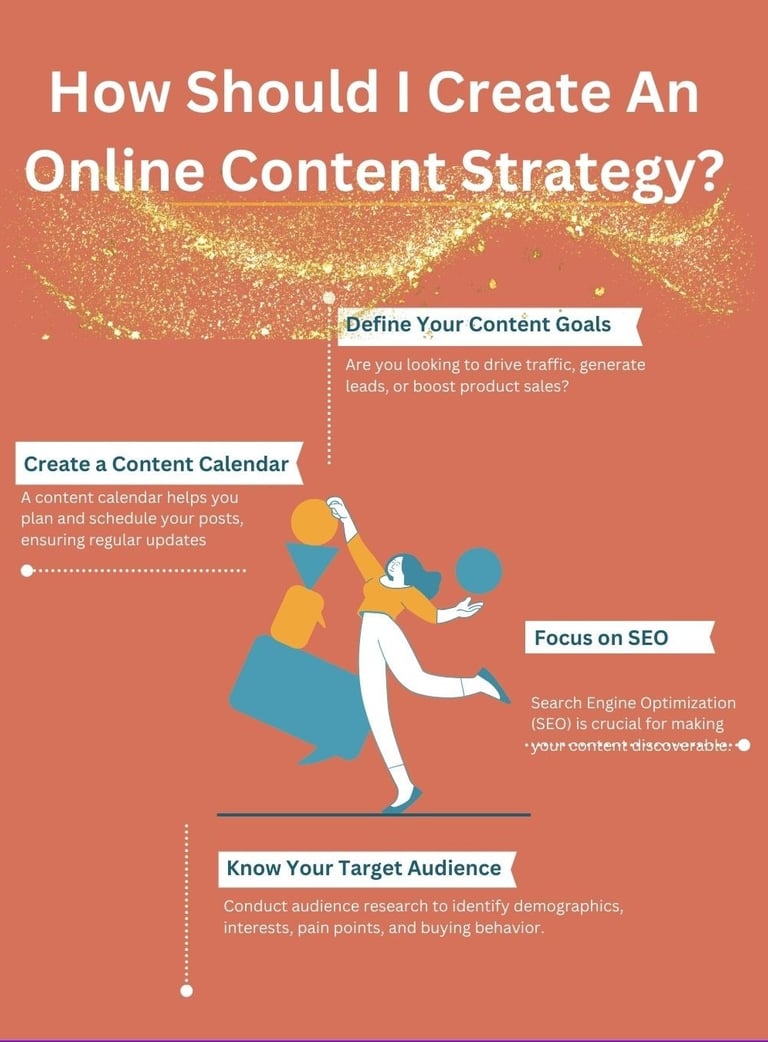Content Creation Strategy for Online Businesses: Boost Your Brand and Drive Sales
Update
2/1/2025


1. Define Your Content Goals
Every successful content strategy begins with clear goals. Are you looking to drive traffic, generate leads, or boost product sales? Identifying your objectives helps align your content with business priorities. For instance, if you aim to increase website traffic, focus on SEO-optimized blog posts. To convert leads, emphasize landing pages and email marketing content.
By setting measurable goals, you can track the performance of your content and make adjustments as needed. Use tools like Google Analytics or SEMrush to monitor metrics such as page views, bounce rates, and conversions.
2. Know Your Target Audience
Understanding your audience is fundamental to creating relevant and engaging content. Conduct audience research to identify demographics, interests, pain points, and buying behavior.
Use tools like Google Trends and social media insights to uncover what your audience is searching for.
Create buyer personas to personalize your content, addressing the specific needs of different customer segments.
By tailoring your content to your audience, you ensure it resonates and delivers value, encouraging repeat visits and conversions.
3. Focus on SEO Optimization
Search Engine Optimization (SEO) is crucial for making your content discoverable. Incorporate high-ranking keywords into your articles, product descriptions, and meta tags to increase your visibility on search engines like Google.
Perform keyword research using tools like Ahrefs or Ubersuggest to identify popular search terms in your niche.
Use a mix of short-tail and long-tail keywords to target broad and specific audience queries.
SEO also involves optimizing images, using header tags strategically, and ensuring fast page load speeds for a seamless user experience.
4. Choose the Right Content Formats
Diversify your content types to engage your audience across multiple platforms. Consider these formats:
Blogs and Articles: Ideal for SEO and sharing in-depth information.
Videos: Highly engaging and perfect for platforms like YouTube and Instagram.
Infographics: Shareable visuals that simplify complex data.
Social Media Posts: Drive engagement and brand visibility.
Experiment with different formats to see which resonates most with your audience.
5. Create a Content Calendar
Consistency is key in content marketing. A content calendar helps you plan and schedule your posts, ensuring regular updates. Include:
Topics aligned with your audience's interests and seasonal trends.
Publishing Dates to maintain consistency and audience expectations.
Platform Strategy for posting on blogs, social media, and email campaigns.
Planning ahead allows you to balance promotional content with value-driven posts.
6. Leverage Social Media
Social media platforms are powerful tools for distributing content and engaging with your audience. Share your blog posts, videos, and infographics on platforms like Facebook, LinkedIn, Instagram, and Pinterest.
Use hashtags to reach wider audiences.
Encourage user-generated content, such as reviews or testimonials, to increase credibility.
Social media analytics tools can help you track engagement and adjust your strategy accordingly.
7. Repurpose and Update Content
Maximize your content's value by repurposing it into different formats. For example, transform a blog post into a video or infographic. Additionally, update older content to maintain relevance and improve SEO rankings.
8. Measure and Refine Your Strategy
Continuously analyze the performance of your content to determine what works best. Key metrics to monitor include:
Website traffic and engagement rates.
Conversion rates from calls to action.
Social media shares and comments.
Use insights to refine your strategy, focusing on high-performing content and eliminating ineffective tactics.
An effective content creation strategy is the backbone of any successful online business. By setting clear goals, understanding your audience, optimizing for SEO, and consistently delivering valuable content across various formats, you can build a strong online presence. As your business grows, refine your strategy using data-driven insights to stay ahead in the competitive digital marketplace.
With the right approach, content creation can drive traffic, engage customers, and ultimately boost sales for your online business.
How Do I Create a Content Creation Strategy for My Online Business?
In the competitive landscape of online business, a strong content creation strategy is essential to building your brand, attracting customers, and driving sales. Effective content not only enhances visibility on search engines but also establishes your authority in your niche and fosters customer trust. Here’s a comprehensive guide to developing a winning content creation strategy for your online business.



ShopNuggets on YouTube
by 21 E-Business Media Network
Nugget-size e-business tips and insights from 21 E-Business Media Network.
Grow your online business in just 1-minute per day! Consistency is the key!🛒
Choose The Best Accounting Tools for Your Business
What are the top accounting software options for small online businesses?
How can accounting tools help manage my e-commerce finances?
What features should I look for in accounting software for my online store?
What are the benefits of cloud-based accounting tools for online retailers?EXPERT ANSWERS HERE!
21 E-Business Media Network
Your total resource for e-business success.
Tools - Resources and Reviews
Montecilla MMR / 21ebizmedia@gmail.com
SUBSCRIBE
for fresh ideas and shop discounts
Some of the links on this website are affiliate links. This means that we may earn a small commission at no extra cost to you if you make a purchase through these links. We only recommend products and services that we trust and believe will add value to our audience. Thank you for supporting us!
© 2024. All rights reserved. Privacy Policy. Terms of service.
